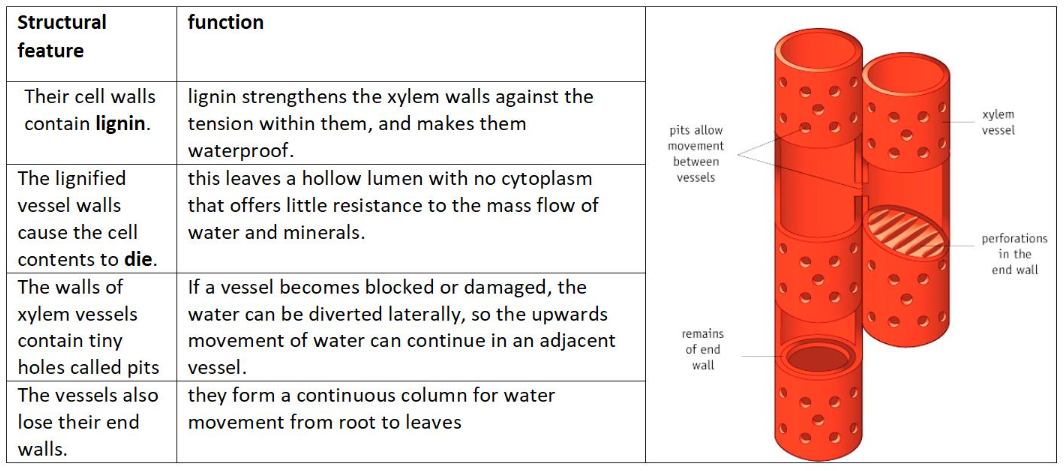PLANTS (MASS TRANSPORT)
1/11
There's no tags or description
Looks like no tags are added yet.
Name | Mastery | Learn | Test | Matching | Spaced |
|---|
No study sessions yet.
12 Terms
TRANSPIRATION:
Transpiration is the process of water movement through a plant and its evaporation from leaves. The continuous columns of water that move from the soil through the roots, stems and leaves to the air are known as the transpiration stream.
WHY DOES TRANSPIRATION OCCUR?
Transpiration is a consequence of gas exchange in leaves.
HOW DOES WATER MOVE THROUGH THE LEAF?
1. When stomata are open, water vapour diffuses from the air spaces in the leaf, out through the stomata, down a water potential gradient. This loss of water is called transpiration.
2. To replace this, water evaporates from the walls of mesophyll cells into the air spaces forming water vapour, which builds up in the air spaces.
3. The water in the mesophyll cells is replaced by water from the xylem vessels in the leaf which are continuous with xylem in the stem.
FEATURES OF XYLEM (4)

COHESION-TENSION THEORY?
· As transpiration occurs through open stomata, water is evaporated from the cell walls of mesophyll cells of the leaf and is replaced by water from the xylem due to the cohesive forces between water molecules.
· This creates negative pressure at the top of the xylem in the stem.
· Water in the xylem is under tension and is pulled up towards the leaves.
· Continuous columns of water are maintained due to cohesion between water molecules
· There is also adhesion of water molecules to the walls of the xylem vessels. This creates an inward pull on the vessel walls as the water is pulled up, causing the xylem vessels to decrease in diameter.
EVIDENCE FOR C-T THEORY:
· Tension has been measured in xylem as plants transpire.
· If a column of water in the xylem is broken, air bubbles in the xylem form and this stops any further upward movement of water in that xylem vessel as the air bubbles prevent cohesion.
· Respiratory inhibitors, such as cyanide or a lack of oxygen, do not inhibit this process.
· The diameter of trees decrease when they are transpiring, (tension pulls xylem walls in), and more so when temperatures and light intensities are higher. This can be measured using a dendrometer.
ADAPTATIONS OF XEROPHYTIC PLANTS?
Waxy cuticle.
Close stomata.

TRANSLOCATION:
Translocation occurs in a tissue known as phloem. Phloem tissue is made up of sieve tube elements, long thin cells arranged end to end. Companion cells are associated with sieve tubes.
SCTRUCTURE OF THE PHLOEM?
· Each sieve tube element links to the next via a sieve plate which is perforated with pores.
· The sieve tube has little cytoplasm, no nucleus, no vacuole and few organelles other than a small number of mitochondria.
· The sieve tubes are alive because of cytoplasmic connections (plasmodesmata) with the companion cell.
· Each companion cell has a nucleus, many mitochondria and other organelles.
MASS FLOW THEORY?
Active transport is used to pump the sucrose (and other solutes) from mesophyll cells of the leaf into companion cells and then into the sieve tube elements of the phloem. This is known as active loading.
This increases the concentration of sucrose (and other solutes) in the sieve tubes in this region.
The increased concentration of sucrose (and other solutes) in the sieve tubes lowers the water potential of the sieve tubes, so water enters by osmosis from the xylem and the companion cells.
This increases the volume within the sieve tubes around the source, which increases the hydrostatic pressure.
At sinks, sucrose is either used up in respiration or converted to starch for storage, so the sucrose concentration of sinks is low.
Sucrose is actively transported from sieve tube elements through companion cells into sink cells.
This increases the water potential of the sieve tube cells and so water leaves the sieve tubes by osmosis entering sink cells (and xylem).
This decreases the volume within the sieve tubes near the sink, which decreases the hydrostatic pressure.
As a result of water entering the sieve tube elements at the source and leaving at the sink, there is a hydrostatic pressure gradient between the source and the sink.
Therefore, there is a mass flow of sucrose solution down this pressure gradient in the sieve tubes.
Sucrose is unloaded from the phloem by active transport from sieve tube elements into sink cells via companion cells.
EVIDENCE FOR MASS FLOW:
· There is high hydrostatic pressure in the phloem as
shown by the release of sap when they are cut.
· The concentration of sucrose is higher in the leaves
(source) than in the roots (sink).
· Downward flow in the phloem occurs in daylight, but
ceases when leaves are shaded, or at night.
· Increases in sucrose levels in the leaf are followed by
increases in the phloem a little later.
· Metabolic inhibitors and/or a lack of oxygen inhibit
translocation of sucrose in the phloem.
· Companion cells have many mitochondria.
EVIDENCE AGAINST MASS FLOW:
· The theory leaves the function of sieve plates unclear as they would hinder mass flow of sucrose – they may have a function in preventing bursting of sieve tubes under pressure. · Not all solutes move at the same speed – they should if moved by mass flow. · Sucrose is delivered at more or less the same rate to all sinks, rather than going faster to those with the lowest sucrose concentration as the mass flow theory would suggest.